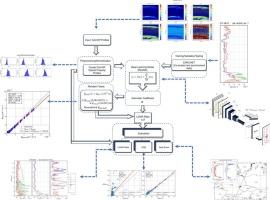Aerosol extinction coefficient estimation over the European troposphere and lower stratosphere using CALIOP profiles
IF 4.4
2区 地球科学
Q1 METEOROLOGY & ATMOSPHERIC SCIENCES
引用次数: 0
Abstract
The aerosol extinction coefficient (AEC) is a critical parameter in atmospheric research, providing valuable insights into aerosol concentration, composition, and their effects on solar radiation, air quality, and climate change. While the Cloud-Aerosol LiDAR with Orthogonal Polarization (CALIOP) onboard the Cloud-Aerosol LiDAR and Infrared Pathfinder Satellite Observation (CALIPSO) satellite offers high temporal continuity in vertical profiling, its AEC retrievals rely on multiple assumptions —such as fixed lidar ratios, layer homogeneity, and pre-defined aerosol models—which introduce uncertainties and limit retrieval accuracy. To address these limitations, this study proposes a deep learning-based method utilizing a ResNet architecture to estimate and retrieve AEC profiles more accurately. The model is trained using CALIOP data and ground-based measurements from European Aerosol Research Lidar Network (EARLINET) stations, enhancing predictive performance and generalization. The proposed model's performance was evaluated across multiple EARLINET stations, CALIOP Level 2 (L2) products, and two major aerosol events—a European dust storm and aged volcanic ash over north Europa—demonstrating robustness across diverse atmospheric conditions. Comparisons of total column Aerosol Optical Depth (AOD) and LiDAR ratio (LR) profiles derived from the estimated AEC with CALIOP L2 retrievals and EARLINET measurements highlighted the model's superior accuracy and generalization. Specifically, the model showed excellent agreement with EARLINET AOD (R2 = 0.98, RMSE = 0.01), significantly outperforming CALIOP (R2 = 0.21, RMSE = 0.06). Moreover, the model provides vertically resolved LR profiles from 0 to 15 km, whereas CALIOP L2 offers limited and often fixed LR values due to missing AEC data and restrictive assumptions. Notably, the backscatter, AEC, and LR profiles produced by the model consistently outperformed CALIOP L2 retrievals when validated against EARLINET Raman measurements. Additionally, AOD estimates showed strong agreement with EARLINET data, achieving R2 and RMSE values of 0.98 and 0.01, respectively, compared to CALIOP's 0.21 and 0.06. The analysis of LR values for the significant aerosol events aligned well with the physical characteristics of these phenomena, underscoring the model's ability to capture complex aerosol behavior across vertical layers of the European troposphere and lower stratosphere.

利用CALIOP剖面估算欧洲对流层和平流层下层的气溶胶消光系数
气溶胶消光系数(AEC)是大气研究中的一个关键参数,为气溶胶浓度、成分及其对太阳辐射、空气质量和气候变化的影响提供了有价值的见解。虽然搭载在云-气溶胶激光雷达和红外探路者卫星观测(CALIPSO)卫星上的正交偏振云-气溶胶激光雷达(CALIOP)在垂直剖面上提供了高时间连续性,但其AEC检索依赖于多个假设,例如固定的激光雷达比、层均匀性和预定义的气溶胶模型,这些假设引入了不确定性并限制了检索精度。为了解决这些限制,本研究提出了一种基于深度学习的方法,利用ResNet架构更准确地估计和检索AEC配置文件。该模型使用CALIOP数据和来自欧洲气溶胶研究激光雷达网络(EARLINET)站点的地面测量数据进行训练,提高了预测性能和泛化能力。该模型的性能在多个EARLINET站点、CALIOP 2级(L2)产品和两个主要气溶胶事件(欧洲沙尘暴和欧洲北部的古老火山灰)中进行了评估,证明了在不同大气条件下的稳定期。将估算AEC的总柱气溶胶光学深度(AOD)和LiDAR比率(LR)曲线与CALIOP L2检索和EARLINET测量结果进行比较,突出了该模型的优越精度和通用性。具体而言,该模型与EARLINET AOD具有良好的一致性(R2 = 0.98,RMSE = 0.01),显著优于CALIOP (R2 = 0.21,RMSE = 0.06)。此外,该模型提供0至15 km范围内的垂直分辨率LR剖面,而CALIOP L2由于缺少AEC数据和限制性假设,只能提供有限且通常固定的LR值。值得注意的是,当与EARLINET拉曼测量结果进行验证时,该模型产生的后向散射、AEC和LR曲线始终优于CALIOP L2检索结果。此外,AOD估计与EARLINET数据非常吻合,R2和RMSE分别为0.98和0.01,而CALIOP的R2和RMSE分别为0.21和0.06。对重要气溶胶事件的LR值的分析与这些现象的物理特征很好地吻合,强调了该模式能够捕捉跨越欧洲对流层垂直层和平流层下层的复杂气溶胶行为。
本文章由计算机程序翻译,如有差异,请以英文原文为准。
求助全文
约1分钟内获得全文
求助全文
来源期刊

Atmospheric Research
地学-气象与大气科学
CiteScore
9.40
自引率
10.90%
发文量
460
审稿时长
47 days
期刊介绍:
The journal publishes scientific papers (research papers, review articles, letters and notes) dealing with the part of the atmosphere where meteorological events occur. Attention is given to all processes extending from the earth surface to the tropopause, but special emphasis continues to be devoted to the physics of clouds, mesoscale meteorology and air pollution, i.e. atmospheric aerosols; microphysical processes; cloud dynamics and thermodynamics; numerical simulation, climatology, climate change and weather modification.
 求助内容:
求助内容: 应助结果提醒方式:
应助结果提醒方式:


